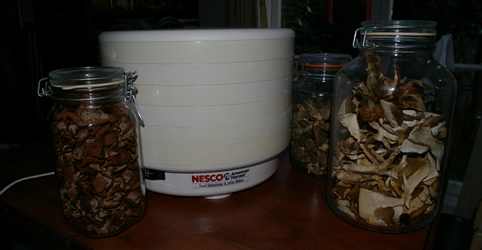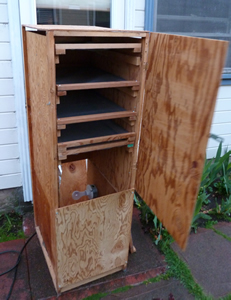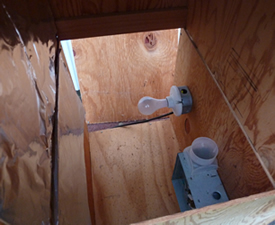Purchasing and Using a Mushroom Dehydrator
When you find enough edible mushrooms that you can no longer eat them all before they rot in the refrigerator, you need to invest in a food dehydrator. No doubt, after MDM, this is your biggest investment in mushroom equipment as a beginner. Which is the best? Which will last? Where can you find one that suits your needs?

Nesco American Harvester dehydrator with dried candy caps, morels, and porcini. © Photo by David Rust
First of all, a dehydrator should last for 10 years or more. The first one I bought was a very inexpensive model (Mr. Coffee) that had NO thermostat. Every beautiful porcini I sliced and dried turned brown and tasted awful from too much heat. We could tell when we cooked with these batches that they were ruined. Your dehydrator should have a thermostat.
Next, how many watts does it use to run? Your dehydrator may be going all day for several days in a row, and that can add up to a hefty electric bill.
Another consideration is ease of cleaning. Spores can deposit themselves all over your trays and on some models, will clog up the fan. When the air is circulating properly, we're looking at billions of spores. Be sure to remove any dirt and bugs after each use. Clean the fan as necessary.
You can buy new, used, or build your own! Here are some options. The three companies below by no means represent a complete list of all food dehydrators. They happen to be the most popular and reliable as recommended by mushroomers.
Option: Excalibur
This is the crème de la crème of dehydrators. Some models have a metal case; some newer models are plastic. Current cost is about $185–$270, depending on the model you choose. Those who own one say it's worth the cost. The Excalibur 3900 9-tray model has both a temperature control and timer. http://www.excaliburdehydrator.com/
Option: Nesco American Harvester
Nesco food dehydrators have a plastic body and trays. Current cost is about $70–$150, depending on the model you choose. With an American Harvester, you can purchase additional trays. The Gardenmaster model has a bottom fan (which can get clogged with spores); the Snackmaster model has a top fan. I've seen people with up to 30 trays full of sliced porcini. http://www.nesco.com/
Option: L'Equip
The L'Equip Model 528 comes with six trays and has a thermostat, with variable controls between 93° and 153°. Current cost of their two models is around $99–$129. http://www.lequip.com/
Option: Build Your Own

When I needed a dehydrator, I heard about one that was being given away. Free! All I had to do was pick it up. It had six built-in screens and a light source for heat. The owner had been using it to dehydrate fruit. It was dusty and stained.
With a screwdriver, I took the entire box apart board by board and cleaned it up. I installed a good light fixture and heavy duty cord (to avoid a fire), a door latch, and a fan. The fan turned out to be too strong, but it works just fine with convection from the light. Gaps at the top allow the air to circulate.
I re-lined the inside with aluminum foil to reflect light and heat, and rebuilt some of the trays. Slow dehydration requires a low watt bulb; for faster drying, thick slices of porcini for instance, I put in a higher watt bulb.
The trays are about 2 feet wide by 3 feet deep. The box stands almost 6 feet tall, so there's lots of room to add additional trays (if I ever get around to it). I would be happy to share the measurements if you want to build something similar.
 |
 |
Option: Go Solar
If you want to save on electricity, just put this phrase into a search engine: "The solar food dryer: how to make and use your own high-performance, sun-powered food dehydrator" and you'll find a book (written by Eben Fodor, a Mother Earth News book, 2005) with detailed instructions.
Dehydrating Mushrooms
When you dry mushrooms, remember they have a high water content — often 98%. Make sure your mushrooms are clean before you dehydrate. If you don't clean your mushrooms, you will find later that grit and bugs are not acceptable in food. As you go through the cleaning process with a brush and knife, inspect carefully to be certain of your identification.

Morel spores left on fan after dehydration of a modest
amount of morels. Be sure to clean the fan!
Some species of mushrooms throw off enough spores to clog the fan of your dehydrator. Be sure to inspect the fan and remove any excess, especially after drying morels! The fan blades below, in the picture to the left, were also covered with a thick spore deposit. Disassembly was required to get in to that part of the mechanism.
Experiment with different methods. Mushrooms that decay quickly must be dried at higher temperatures. Candy caps can lose their aroma if dried too fast. Some mushrooms must be sliced; others can be dried whole. Mushrooms must be absolutely dry when they are stored. Otherwise, bugs and mold will survive. There's nothing more heartbreaking than a 4 liter jar of spoiled morels. Some people use air evacuating systems; or you can purchase glass jars (with a rubber seal). Regular sealable plastic bags absorb too much moisture and are not a long term solution. Check periodically to see that your mushrooms remain crispy dry.
Note: dehydrators blow a high volume of spores in to the air. Some people have developed allergies from breathing this effluent. Dry your mushrooms away from your main living area!
Finally, if you've gone to all this trouble, use the mushrooms or give them to friends. Like a fine wine, many fungi improve with age. Be generous with your meal preparation and with your friends.
© David Rust

